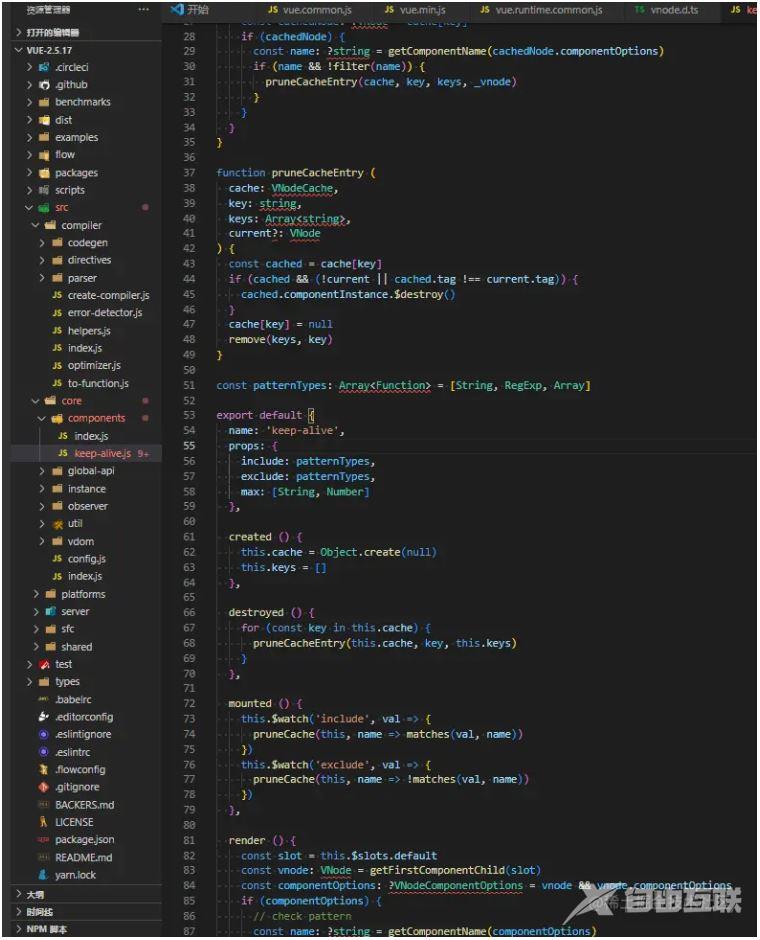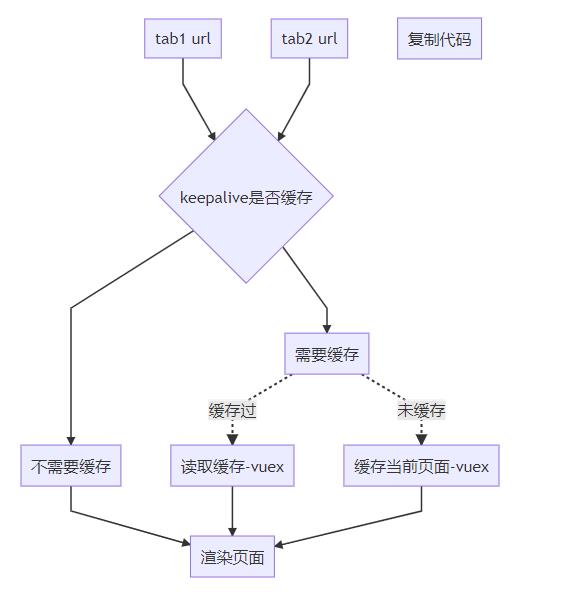目录 vue自定义keepalive组件 为什么会出现这种情况呢 如何解决这个问题呢 问题知道了怎么解决呢 思路有了撸代码 如何使用 主题说完了,整点其他的 vue自定义keepalive组件 前一阵来了一
目录
- vue自定义keepalive组件
- 为什么会出现这种情况呢
- 如何解决这个问题呢
- 问题知道了怎么解决呢
- 思路有了撸代码
- 如何使用
- 主题说完了,整点其他的
vue自定义keepalive组件
前一阵来了一个新的需求,要在vue项目中实现一个多开tab页面的功能,本来心想,这不简单嘛就是一个增加按钮重定向吗?(当然如果这么简单我就不写这个文章了)。很快写完,提交测试。测试大哥很快就提交了一个问题:"你两个tab页访问同一个链接,怎么还是个联动的呢?"。我擦,这指定是缓存的问题。
为什么会出现这种情况呢
keep-alive组件是使用
includeexclude这两个属性传入组件名称来确认哪些可以被缓存的
<keep-alive exclude="a,b,c" >
<router-view></router-view>
</keep-alive>
我们在看一下源码,看看人家是怎么实现的(这两张图截的真难看)

主要逻辑(直说上述代码)就是根据传入的
include,exclude两个属性传入数组,根据当前访问的组件名称判断。我们相同链接都访问同一个组件名称(name)相同,第二次访问的时候,链接指向的是同一个组件,因为使用组件的name作为缓存key,此时会被认为是读取缓存操作,就会直接加载缓存并渲染,所以出现了两个tab页访问同一个链接,出现联动情况
如何解决这个问题呢
这个比较简单之前是因为组件name当key导致的,那我们就不使用组件的name作为key了,改为name+tab的index作为key。
问题知道了怎么解决呢

思路有了撸代码
group-keep-alive.js
function remove(arr, item) {
if (arr.length) {
var index = arr.indexOf(item)
if (index > -1) {
return arr.splice(index, 1)
}
}
}
function getFirstComponentChild(children) {
if (Array.isArray(children)) {
for (var i = 0; i < children.length; i++) {
var c = children[i]
if (isDef(c) && (isDef(c.componentOptions) || isAsyncPlaceholder(c))) {
return c
}
}
}
}
function isDef(v) {
return v !== undefined && v !== null
}
function isAsyncPlaceholder(node) {
return node.isComment && node.asyncFactory
}
var patternTypes = [String, RegExp, Array]
export default {
name: 'keep-alive',
abstract: true,
computed: {
// 这里算是一个伪代码
// 缓存的数组 [{ 'tab1/组件名称':comp, 'tab2/组件名称':comp },{ 'tab1/组件名称':comp, 'tab2/组件名称':comp }]
cacheArray() {
return this.$store.state.xxx.groupCache
},
// 当前选中的分组 例:0/1/2... 这里用来读取cache数组的index
groupIndex() {
return this.$store.state.xxx.groupIndex
}
},
created: function created() {
// 当前tab的缓存
const cache = this.cacheArray[this.groupIndex]
this.cache = cache || Object.create(null)
// TODO 页面初始化事件,后续可触发初始化事件
},
destroyed: function destroyed(to, form) {
// TODO 页面离开事件,后续可触发关闭事件
},
render: function render() {
var slot = this.$slots.default
var vnode = getFirstComponentChild(slot)
var componentOptions = vnode && vnode.componentOptions
// check pattern
var ref$1 = this
var cache = ref$1.cache
const key = `${this.groupIndex}/${componentOptions.Ctor.options.name}`
// 存在key直接读取
if (cache[key]) {
vnode.componentInstance = cache[key].componentInstance
} else {
// 没有进行缓存
cache[key] = vnode
}
// 写入缓存
this.$store.dispatch('setGroupCache', {
cache: this.cache
})
return vnode || (slot && slot[0])
}
}
如何使用
意思一下就行了
<group-keep-alive>
<router-view :key="key" />
/group-keep-alive>
// key一定要区分
computed: {
key() {
return `${选中index}/${fullpath}`
},
}
主题说完了,整点其他的
1. 在group-keep-alive组件中设置了abstract: true,设置当前组件为抽象组件,我的李姐:就是一个对下一级(包含子元素)事件监听等提前拦截,从而对下一级进行操作
2. router-view :key="key" 这key的作用是用来区分同一个组件是不是重复使用一个实例。
到此这篇关于vue自定义keepalive组件的文章就介绍到这了,更多相关vue keepalive组件内容请搜索易盾网络以前的文章或继续浏览下面的相关文章希望大家以后多多支持易盾网络!

